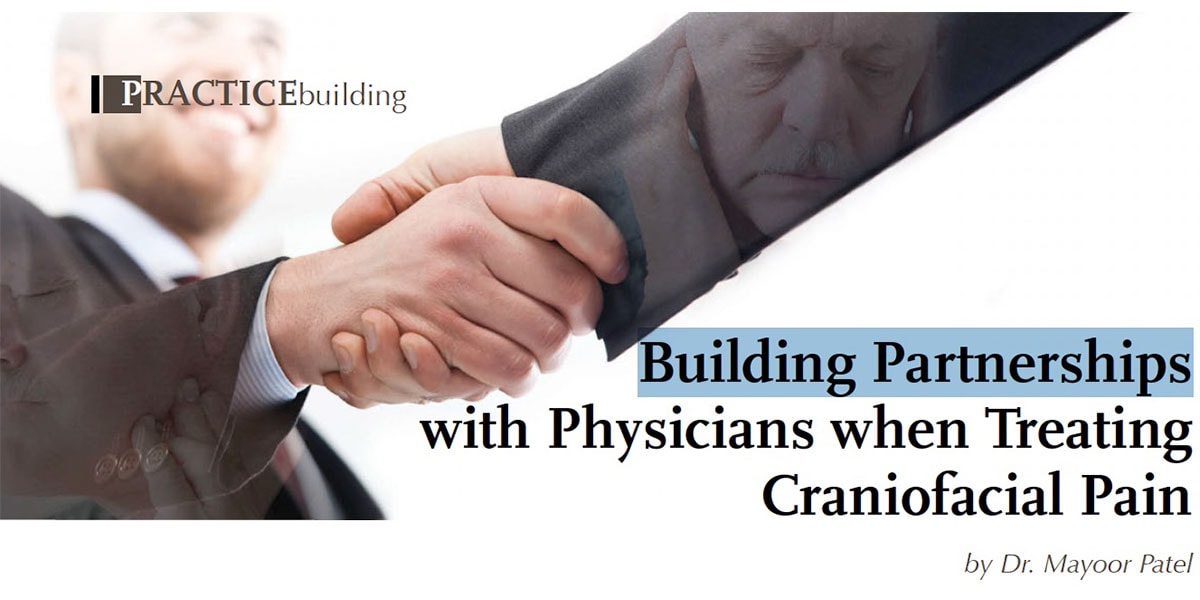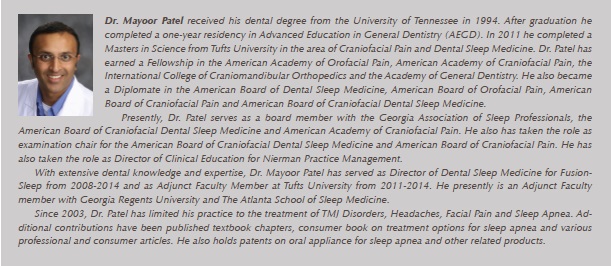
It has been estimated that approximately 45 million Americans complain about headaches alone each year; almost 1 out of every 6 people. Pain referral patterns can result in misdiagnosis, potentially leading to unnecessary or ineffective treatment. With such a large portion of the population not getting the right treatment for what are often debilitating disorders, there is an incredible need for dentists, trained in diagnosis of common pain complaints in the head and neck, to connect with other healthcare providers.
Often referred to as “The Great Imposter” due to the wide array of symptoms that may mimic other conditions, diagnosing and treating temporomandibular joint disorders (TMD) and craniofacial pain is an important responsibility of the dentist. Ranging from headaches to ear pain to jaw pain and even tooth or sinus pain, your patients can feel discomfort without being able to specify many details. At times, the cause is of dental origin but there are many other reasons to consider.
Assessing craniofacial pain is a team effort, with the patient’s Dentist, GP, ENT, Neurologist, Physiatrist, Physical Therapist, and Psychiatrist all potentially playing a role in diagnosis and treatment. A dentist must understand what physicians do in their diagnostic workups and treatments and when it’s necessary to refer out to truly understand their own role and fulfill the dentist’s duties in patient care. Although the majority of head and facial pain symptoms are benign, they can be a harbinger of a more serious underlying disease.
Establishing referral relationships across many physician specialties provides the dentist with needed resources. Additionally, just as the medical professionals you’ll be working with are billing medical insurance, most medical insurance covers craniofacial pain diagnosis and/or treatment, even when performed in a dental office. Your comfort with billing medical insurance and the fact that over 30 states have mandated coverage for craniomandibular or temporomandibular joint disorders is important to share with physicians you’ll be working with and will increase their confidence in making a referral.
What is Craniofacial Pain?
The field of craniofacial pain/orofacial pain treatment refers to pain associated with the hard and soft tissues of the head, face, and neck. This includes the diagnosis and management of complex acute and chronic craniofacial pain disorders which may be categorized as neuropathic, neurovascular, chronic regional pain syndrome, masticatory with interrelated cervical pain disorders, headache disorders, TMD, craniofacial sleep disorders, and other disorders causing persistent pain and dysfunction.1, 2
The potential for pain arising from and referred to the trigeminal receptive fields is why evaluation and management of orofacial pain requires collaboration among many fields of medicine.3 It is important for dentists to understand what their responsibilities in treatment are in order to effectively conduct their portion of care, while also developing working relationships with medical colleagues.
When it comes to aspects of craniofacial pain such as headaches, migraines and jaw pain, the underlying cause can often go undiagnosed, or even misdiagnosed. The general assumption is it’s “just a headache or some sort of pain.” Patients may feel that taking an analgesic to make the pain go away is all that is necessary. Without diagnosis, the cause cannot be addressed and clinically important time may pass without proper action. By learning how to diagnose and treat craniofacial pain, dentists gain a great power to change their patients’ lives. With great power comes great responsibility for the proper diagnosis and management of pain in and around the mouth, face and neck.4 The complete dentist is cautious about assuming her/his treatment plan will always be the only treatment required.
Why Develop a Working Relationship with a Medical Professional?
 Many patients will find themselves in a neurological, primary care, chiropractic, pain management or an ENT’s office, but that may not always be the best place to receive appropriate care. As the graphic shows symptoms can present in many other areas.
Many patients will find themselves in a neurological, primary care, chiropractic, pain management or an ENT’s office, but that may not always be the best place to receive appropriate care. As the graphic shows symptoms can present in many other areas.
In many cases, medical practitioners and dentists are stumped by the vast crossover of symptoms their patients are experiencing. For example, a patient may complain of TMJ pain, but is actually suffering from a disease or infection of the ear, nose or throat. It is also common for a patient to complain of ear pain when in fact the pain is related to an affected TMJ (see image). These patients may be in the incorrect practice seeking treatment, or the clinician is frustrated that prescribed therapy based on the symptoms are not resolving the patient’s complaints.
I’ve stated that craniofacial pain may be caused by conditions other than dental in nature. Whether it is neurological or sinus related, you want your patients to get the best care available, and that means joining forces with other medical professionals. From neurologists and otolaryngologists to family practitioners, it is important to create a working relationship with each in order to discuss or refer for diagnosis and management of your patients when further assistance is needed.
How Do You Develop a Working Relationship?
In order to create this working relationship, it is important that you give physicians and their staff confidence that your practice will provide exceptional care for their patients. By speaking their language and sending standard medical SOAP format narratives that document your patients’ treatment, you demonstrate to physicians that your practice has established proper protocols.

Medical professionals prefer written communications about their patients. Typically, a brief narrative describing subjective findings, objective findings, assessments and the proposed treatment plan (SOAP) is the preferred method. At my office, we utilize DentalWriter™ software—it is our workhorse. For every patient examined, a letter is sent to their primary care doctor, dentist, and the referral source. Letters are only sent if patients provide us with a HIPAA release allowing us to share their information. Generally, our patients are happy to allow us to send such communications to the appropriate medical professionals and often this is the first time they’ve seen such a commitment to collaborative care.
Three letters will be sent: When we see a new patient, if treatment is initiated, and at completion of treatment. With every initial letter we will attach a one-page fact sheet that is a compilation of summarized abstracts from journals that the respective specialist may read. The abstracts are research papers showing the associated symptoms with TMD such as headaches, jaw pain, unexplained tooth pain, otalgia and so on. We have one for Primary Care Medicine, Neurology, ENT, Sleep Physicians and Dentistry. We include a sheet with every letter to the respective specialty in order to help educate the Physician Assistant (PA), Nurse Practitioner (NP) or the physician themselves of symptoms that mimic TMD and alert them to cases that they may not have seen success in.
 When it comes time to refer a patient due to uncertainty or the need of a specialist to help with diagnosis and management, picking up the phone works. Interestingly, I never have experienced a push back from the physicians when we asked about a patient that we would like to send over. Over time, your patients will help you learn important bedside manners that a physician exhibits when they may have seen them for their symptoms. We keep a record of the physicians we have heard positive things about and try to utilize them for patients we may need to refer. We prefer to use medical professionals that are close to the patient’s work or home.
When it comes time to refer a patient due to uncertainty or the need of a specialist to help with diagnosis and management, picking up the phone works. Interestingly, I never have experienced a push back from the physicians when we asked about a patient that we would like to send over. Over time, your patients will help you learn important bedside manners that a physician exhibits when they may have seen them for their symptoms. We keep a record of the physicians we have heard positive things about and try to utilize them for patients we may need to refer. We prefer to use medical professionals that are close to the patient’s work or home.
Additionally, I try and make it a point to go to the physician’s office to introduce myself. While there, I may also get a chance to speak or meet with the office manager or the referral coordinator. I find that face-to-face time with the NP and PA pays off better. Ultimately, the NP and PA see many patients for follow-up care, and by educating them on what we do, we can help with getting referrals. Conversely, I have yet to have a negative response when advising them that we have patients that may come to us first and may need their area of specialty to assist with diagnosis and management.
Another good way to develop a working relationship and to have physicians understand what you can offer their patients is an in-service to educate their medical team. Once we have utilized a physician and have set up a lunch meeting, we will bring in lunch and present, in brief, all the high points of what a dentist such as myself can offer to their patients. The opportunity at hand allows face-to-face time for the medical professionals and their team to meet you and ask questions. Time is always valuable so keep your presentation short and to the point.
Join forces with other medical professionals to provide the best care for your patients. Whether it is ear, dental or head related, a working relationship with the medical professionals in your community is essential in providing proper treatment and becoming a hero to your patients!
References:
Bell WE: Orofacial Pain. Classification, diagnosis, management. 4th edition. Chicago:Year book medical publishers, 1989
Simmons CH: Craniofacial Pain. A handbook for assessment, diagnosis and management. Chattanooga: Chroma inc, 2009
de Leeuw R: Orofacial Pain. Guidelines for assessment, diagnosis and management. 4th edition. Chicago: Quintessence Publishing, 2008
Okeson JP: Bells oral and facial pain. 7th edition. Chicago: Quintessence Publishing, 2014





